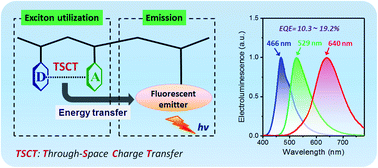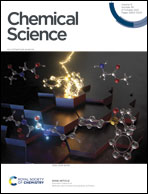Hyperfluorescent polymers enabled by through-space charge transfer polystyrene sensitizers for high-efficiency and full-color electroluminescence†
Abstract
Fluorescent polymers are suffering from low electroluminescence efficiency because triplet excitons formed by electrical excitation are wasted through nonradiative pathways. Here we demonstrate the design of hyperfluorescent polymers by employing through-space charge transfer (TSCT) polystyrenes as sensitizers for triplet exciton utilization and classic fluorescent chromophores as emitters for light emission. The TSCT polystyrene sensitizers not only have high reverse intersystem crossing rates for rapid conversion of triplet excitons into singlet ones, but also possess tunable emission bands to overlap the absorption spectra of fluorescent emitters with different bandgaps, allowing efficient energy transfer from the sensitizers to emitters. The resultant hyperfluorescent polymers exhibit full-color electroluminescence with peaks expanding from 466 to 640 nm, and maximum external quantum efficiencies of 10.3–19.2%, much higher than those of control fluorescent polymers (2.0–3.6%). These findings shed light on the potential of hyperfluorescent polymers in developing high-efficiency solution-processed organic light-emitting diodes and provide new insights to overcome the electroluminescence efficiency limitation for fluorescent polymers.



 Please wait while we load your content...
Please wait while we load your content...